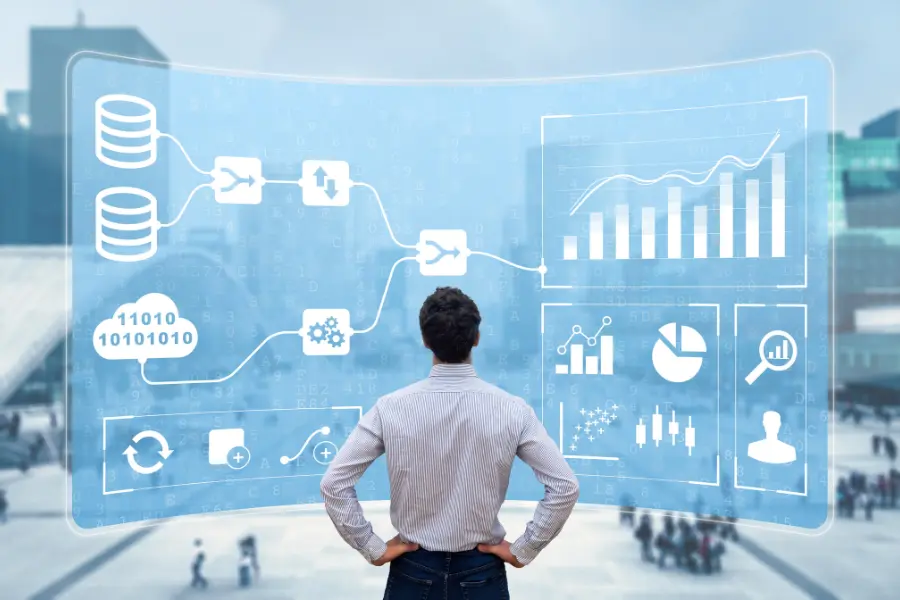How Virtual Reality Enhances Data Visualization for Deeper Insights
Virtual reality (VR) is revolutionising data visualisation by offering immersive experiences that enable users to explore and interact with data in three-dimensional (3D) space. Here’s an exploration of how VR enhances data visualisation for deeper insights:

Virtual Reality and Data Visualization
1. Immersive Visualisation Environment
Spatial Representation: VR transforms data visualisation from 2D charts and graphs into 3D immersive environments. Users can visualise data points, trends, and relationships spatially, gaining a deeper understanding of complex datasets.
Interactive Exploration: VR allows users to navigate through data visualisations intuitively. They can zoom in, rotate, and manipulate visual elements, enhancing the ability to explore data from different perspectives.
2. Enhanced Data Perception
Depth and Scale: VR provides depth perception, allowing users to perceive the relative size and importance of data points based on their spatial arrangement. This helps in identifying patterns and outliers more effectively.
Contextual Understanding: By placing data visualisations in realistic or abstract environments, VR provides context that aids in understanding data within its broader implications or real-world applications.
3. Collaborative Analysis
Virtual Meetings and Collaboration: VR enables multiple users from different locations to meet in a shared virtual space and interact with data visualisations collaboratively. This fosters teamwork, knowledge sharing, and collective decision-making based on shared insights.
Remote Data Exploration: Researchers, analysts, and decision-makers can remotely explore complex datasets together in real-time, leveraging VR’s immersive capabilities to discuss findings and hypotheses.
4. Real-Time Interactivity
Dynamic Data Updates: VR platforms can visualise real-time data streams or dynamically updated datasets, providing instant insights into changing trends or patterns.
Interactive Dashboards: VR allows users to interact with live data dashboards, adjusting parameters, filtering data subsets, and visualising simulations or scenarios in real-time.
5. Applications Across Industries
Scientific Research: VR enhances data visualisation in scientific research by visualising complex models, simulations, and experimental data in 3D, aiding in understanding phenomena and validating hypotheses.
Architecture and Design: Architects and designers use VR to visualise building designs, urban planning models, and environmental simulations, incorporating real-time data on factors like sunlight exposure or environmental impact.
Healthcare and Medicine: VR aids medical professionals in visualising patient data, anatomical structures, and medical imaging (e.g., MRI scans), facilitating surgical planning, education, and patient engagement.
6. Challenges and Considerations
Hardware Requirements: VR requires specialised hardware such as headsets and controllers, which may limit accessibility and adoption in some environments.
Data Integration and Compatibility: Integrating VR with existing data systems and ensuring compatibility with different data formats and sources can be challenging.
User Training and Adoption: Users may require training to effectively navigate and interpret data visualisations in VR, especially if they are unfamiliar with immersive technologies.
7. Future Directions
Advancements in VR Technology: Continued advancements in VR hardware and software will improve visual fidelity, interaction capabilities, and scalability for enterprise-level data visualisation applications.
Integration with AI and Machine Learning: AI-driven algorithms will enhance VR data visualisations by automating insights generation, anomaly detection, and predictive analytics within immersive environments.
Virtual reality offers a transformative approach to data visualisation, enabling deeper insights through immersive, interactive experiences. By leveraging VR’s spatial visualisation and collaborative capabilities, organisations can enhance decision-making, accelerate innovation, and gain competitive advantages in understanding and leveraging their data effectively.
Active Events
Best Tips to Create a Job-Ready Data Science Portfolio
Date: April 30, 2025 | 7:00 PM(IST)
7:00 PM(IST) - 8:10 PM(IST)
2811 people have registered
Unlocking Lucrative Earnings: Mastering Software Engineering Salaries
Date: April 29, 2025 | 7:00 PM(IST)
7:00 PM(IST) - 8:10 PM(IST)
2811 people have registered
Bootcamps
Data Science Bootcamp
- Duration:8 weeks
- Start Date:October 5, 2024
Full Stack Software Development Bootcamp
- Duration:8 weeks
- Start Date:October 5, 2024
